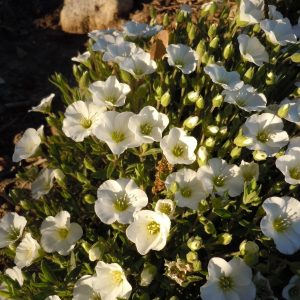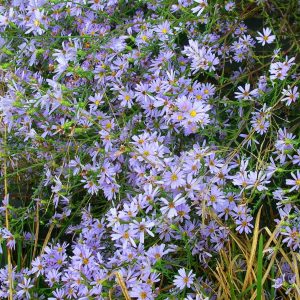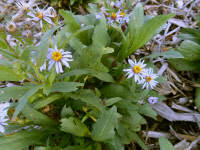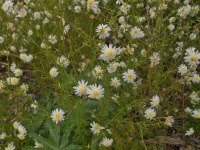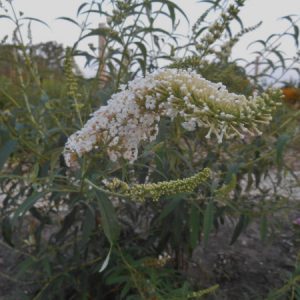Archives
Showing 25–32 of 199 results
-
Arenaria montana Sandwort, Mountain sandwort Z. 4-8
Perky white flowers mass over a mound of evergreen foliage, May – June. “…(A) very ornamental plant …(with) fine pure white and large flowers … the white flowers appear so thickly in early summer as to obscure the foliage.” Alpine Flowers for English Gardens 1911
ARCHIVED
Note: This is a plant not currently for sale. This is an archive page preserved for informational use.
Perky white flowers mass over a mound of evergreen foliage, May – June. “…(A) very ornamental plant …(with) fine pure white and large flowers … the white flowers appear so thickly in early summer as to obscure the foliage.” Alpine Flowers for English Gardens 1911.
Size: 4-6” x 8-12”
Care: sun to part shade in well-drained soil, shallow rooted so needs occasional water.
Native: Pyrenees Mountains – France & Spain
Awards: England’s Royal Horticultural Society Award of Merit.Collected before 1753. Arenaria from arena meaning “sand”, the condition for many of the species. Montana means “mountain.”
-
Artemisia ludoviciana Silver sage, Wormwood Z 4-9
Grown for its silver-grey foliage in the garden & dried in arrangements.
ARCHIVED
Note: This is a plant not currently for sale. This is an archive page preserved for informational use.
Grown for its silver-grey foliage in the garden & dried in arrangements
Size: 3’ x 2’ and spreading
Care: sun in well-drained soil
Native: Colorado south to Texas, west to California.
Size: Cut fresh or dried flowers, prairie gardenBlackfoot used the leaves to clean themselves as part of religious rituals. California’s Shasta Indians used the leaves to prepare dead bodies to be buried. HoChunk made a smudge to revive the unconscious. Cahuilla Indians made baskets and roofs and walls of their homes with the stems. First collected for gardens by Meriwether Lewis October 1, 1804 in South Dakota. Artemisia named for the wife of Mausolus, king of Caria, who began using the plants and adopted it as hers. Miller 1768.
-
Asclepias verticillata Whorled milkweed Z 4-10 POISON
Fragrant flat-topped clusters of many small white flowers atop single stem surrounded by narrow, grass-like leaves. Blooms July through October.
ARCHIVED
Note: This is a plant not currently for sale. This is an archive page preserved for informational use.
Fragrant flat-topped clusters of many small white flowers atop single stem surrounded by narrow, grass-like leaves. Blooms July through October.
Size: 12-30” x 12-24” spreading
Care: sun to part shade in moist well-drained to well-drained soil
Native: all US, Wisconsin native
Wildlife Value: deer & rabbit resistant. Bees & butterflies eat nectar. Host for Monarch caterpillars.
Size: root used to induce sweating for Choctaw, Chickasaw and Creek nativesCollected by 1753. Grown at America’s 1st botanic garden, Elgin Botanic Garden 1811.
-
Aster azureus syn. Symphyotricum oolentangiense var. oolentangiense Sky blue aster Z 3-9
Showy true cornflower-blue daisies in August-October
ARCHIVED
Note: This is a plant not currently for sale. This is an archive page preserved for informational use.
Showy true cornflower-blue daisies in August-October
Size: 2-3’ x 2’
Care: full sun to part shade in any soil
Native: NY to SD, FL to TX incl. WI
Wildlife Value: Aster species are nectar sources for many butterflies – Checkered white and Checkered skippers, Spring azure, Pearl crescent, Buckeye, Painted lady, Fiery skipper, Sachem, Sleepy orange, Silver-spotted skipper and Monarch.Collected before 1889.
-
Aster sibiricus syn. Eurybia sibirica Siberian aster, Arctic aster Z 3-9
Lavender daisies from late-summer into fall
ARCHIVED
Note: This is a plant not currently for sale. This is an archive page preserved for informational use.
Lavender daisies from late-summer into fall, valuable for long-blooming and short size
Size: 6-10” x 15-24” Care: sun in well-drained, to moist well-drained, acidic soil
Native: NW US, Alaska, Canada, Arctic & Siberia
Wildlife Value: attracts butterfliesCollected by German plant hunter Johann Gmelin in Siberia before 1753
-
Asteromoea mongolica syn. Aster mongolicus or Kalimeris pinnatafida ‘Hortensis’ Japanese aster, Mongolian aster Z 3-9
Covered with petite double white daisies, blooming for months –late summer-fall
ARCHIVED
Note: This is a plant not currently for sale. This is an archive page preserved for informational use.
Covered with petite double white daisies with golden stamens blooming for months –late summer-fall.
Size: 2-3’ x 1-2’
Care: sun to part shade in well-drained to moist well-drained soil
Native: Japan
Awards: Georgia Gold Medal 1998 Taxonomists had trouble naming this one. First described in French Journal Nouv. Arch. Mus. Hist. Nat. in 1882. A favorite flower of the late garden writer Elizabeth Lawrence who traced it to the grounds of the old Oxford Orphanage in Oxford NC. (1942) -
Baptisia tinctoria Wild indigo, Horsefly Z. 3-9
Sweet saffron yellow pea-like flowers, July to September
ARCHIVED
Note: This is a plant not currently for sale. This is an archive page preserved for informational use.
Sweet saffron yellow pea-like flowers, July to September
Size: 2-3’ x 2-3’
Care: sun to part shade in dry to moist well-drained soil
Native: Ontario, Maine to MN S to GA, Wisconsin
Wildlife Value: Attracts butterflies.Baptisia is Greek meaning “to dye” referring to use of Baptisia australis as a substitute for indigo dye. Tinctoria means used in dying. For Cherokee it induced vomiting. They made a poultice to “stop mortification.” The root, held against teeth, remedied toothache. Iroquois used it to cure rheumatism and cramps in the stomach or legs. The Cherokee & Ojibwa used it for dye. Collected by John Banister in Virginia by 1692. Pressed specimen in Emily Dickinson’s herbarium.
-
Buddleja davidii var. alba White butterfly bush Z 5-9
Fragrant, honey-scented, large, white, arching spikes
ARCHIVED
Note: This is a plant not currently for sale. This is an archive page preserved for informational use.
Fragrant, honey-scented, large, white, arching spikes from summer through fall.
Size: 6’ x 4’
Care: Sun in well-drained soil
Native: Central & Western China
Wildlife Value: flowers very fragrant, attracts many butterflies, excellent cut flowerBuddleja named to honor Reverend Adam Buddle, Vicar of Farmbridge in Essex and botanist. (1662-1715) Davidii honors Fr. Armand David a French missionary who noticed it. White flowered variety was described by Ernest Henry “Chinese” Wilson in 1913.

